Visiting the Museo San Agustin is a relaxing retreat in the hurly-burly of metropolitan life. It enriches both the spirit and our knowledge of history. It provides us information on the accomplishments of Augustinians as it emanates from the spirituality St. Augustine of Hippo.
One relaxing spot in the Museum Complex is the courtyard. It is a nice garden with a fountain. It is said that fountains are central to Augustinian spirituality.
 |
| At the fountain in the courtyard of Museo San Agustin. |
An interesting portrait that welcomes the visitors to the museum is that of Fr. Diego de Herrera who is being considered for sainthood. He was martyred for his faith in Batalay, Bato, Catanduanes. There is a shrine built over the burial place of Fr. Herrera which to this day has a spring of clear water. The locals believe that the water has healing powers and such an unusual phenomenon.
 |
| Fr. Diego de Herrera, an Augustinian martyred in Batalay, Catanduanes. |
The See of Caceres was also once headed by an Augustinian in the person of Bishop Arsenio Campo, O.S.A.
 |
| Bishop Arsenio Campo, O.S.A. of the See of Nueva Caceres |
What I like in visiting Augustinian edifices are the massive paintings they display on the wall. One example is the Basilica Minore del Sto. Niño de Cebu where they hang on the wall large paintings depicting historical scenes involving Augustinian friars such as Fr. Andres de Urdaneta, O.S.A. In the same way, there are large, beautiful paintings installed on the walls of Museo San Agustin, such as those presented below.
 |
| A Painting Depicting St. Augustine. |
 |
| St. Augustine was baptized by St. Ambrose who was then the Bishop of Milan. |
 |
| Blessed Fr. Pedro de Zuñiga was burned to death in Nagasaki, Japan. |
The Augustinians like other religious orders also prepared Choir Books for their worship. They do it with delicate craftsmanship. The museum was able to preserve one copy.
 |
| An Augustinian Friar writing a Choir Book. |
 |
| Augustinian Friars who are painters of Cantorales or Chant Books. |
 |
| The Choir Book made by an Augustinian friar. |
As a Chemical Engineer who is interested in drug development, one section of the museum captured my attention. It was the lithographs of Philippine plants prepared by Fr. Manuel Blanco, O.S.A. as well as the Botica where the medicines on sale were prepared by Augustinian friars. They produced the medicines from Philippine medicinal plants.
 |
| Original Lithographs of the "Flora de Filipinas" by Fr. Manuel Blanco, O.S.A. |
 |
| Brother Hilario Calvo, Pharmacist at San Augustin and he wrote about medicinal plants. |
 |
| Tools used in preparing the medicines. |
 |
| Pharmacy Pots in the Botica de San Agustin |
As a lover of antiquity, I particularly love this retablo found inside the museum. It is like a "Wall of Fame" for holiness. They also have bass reliefs of depicting Augustinian saints and friars doing their works.
 |
| Retablo of Augustinian Saints |
 |
| A bas relief depicting an Augustinian saint. |
 |
| A bas relief depicting the martyrdom of an Augustinian friar. |
 |
| A bas relief depicting an Augustinian saint. |
 |
| St. Ignatius of Loyola and St. Francis Xavier |
 |
| St. Robert Bellarmine and St. John Berchmans |
They also exhibit there the things used inside the church such as the tabernacle, statues for veneration, monstrance, and liturgical vessels. These items are ornate in character. They also display the standards of saints being used during procession, the mass guides and other publications.
 |
| Antique tabernacles used in San Agustin Church. |
 |
| Image of Sto. Niño de Cebu |
 |
| Image of St. Michael the Archangel |
 |
| The Resurrected Christ with St. Peter and St. Paul. |
 |
| Monstrance and Liturgical Vessels |
 |
| Standards of Augustinian Saints |
 |
| Standard of the Blessed Virgin Mary |
 |
| Books Written by Augustinians |
I also love the ornate furniture used by the friars during antiquity. They witnessed history as it unfolded not only in Intramuros but throughout the country. They should have a highly skilled sculptor at that time and of course high-quality wood.
 |
| Marble Wash Basin |
A very important part of the museum is the vault where the remains of Juan Luna y Novicio is being kept. He is a famous Filipino painter known for his magnum opus Spoliarium. He was also a sculptor, a political activist of the Philippine Revolution during the late 19th century, and a diplomat.
 |
| Vault which contains the remains of Juan Luna y Novicio. |
After being toured in the museum by an Augustinian Seminarian, I was treated by the Museum Curator, who happens to be my cousin, to a snack in his office.
 |
| With Fr. Ricky B. Villar, OSA, the Museo San Agustin Curator (left) and his two confreres in the Augustinian religious order. |
I encourage the faithful to donate to the museum to help defray the cost of operation and artifacts preservation for the enjoyment of future generations who will visit or research in the museum. As a visitor of the museum, you will really enjoy there while learning more about Philippine history and its intersection with the Roman Catholic Church institution.



































Comments
Post a Comment